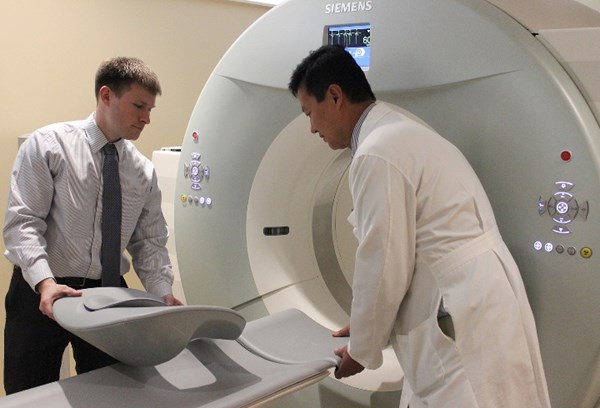KNOXVILLE, Tenn., Sept. 5, 2013 (GLOBE NEWSWIRE) -- A breakthrough in medical imaging is expected to produce significantly better images for physicians while also potentially reducing scan times and radiation exposure for patients undergoing PET/CT scans. A test phase with the new technology, called continuous bed motion, proved so promising at The University of Tennessee Medical Center that the hospital changed its protocols and will now only scan PET/CT patients with the new imaging technique.
"We have seen reductions in CT dose of up to five percent," said Dr. Yong Bradley, chief of nuclear medicine at UT Medical Center and the University of Tennessee Graduate School of Medicine. "That may not sound like much, but for patients with cancer who may receive multiple imaging procedures as part of their treatment, it can add up to a considerable reduction in radiation exposure."
The Knoxville hospital played a role throughout the past decade in consulting with and assisting Siemens Molecular Imaging in the development of the new technique. The medical center is one of two facilities in the world to recently test the new scanner, called the Biograph mCT Flow, throughout the spring and summer.
"The flexibility of the mCT allows me to create a personalized imaging sequence specific to each patient," Bradley added. "The imaging is completed much more quickly than with a traditional system and it produces significantly higher quality images, leading to the opportunity for enhanced diagnosis on behalf of the patient."
Typical PET/CT scanning is performed using a process called step and shoot, which means that the imaging device scans small sections of the body at a time. With Siemens' new patented FlowMotion technology, the bed holding the patients moves seamlessly and continuously through the machine, as the scanner continues to image the body. Physicians are able to create a more personalized care plan throughout that process for each area of the body, which can greatly reduce overall scan time and provide a scan that is optimized for imaging each patient's disease.
The optimized imaging conditions, according to Bradley, are what lead to the overall CT radiation dose reduction for many patients.
"This fundamentally changes the way we think about PET/CT imaging," said Dustin Osborne, PhD, assistant professor of radiology at UT Graduate School of Medicine and director of clinical research for the molecular imaging and translational research program. "Every current textbook teaches the step and shoot method and the associated challenges. But with continuous bed motion, the way we have to think about the imaging protocol is completely different. And it's much better for patients."
The software for the continuous bed motion technology is FDA-approved. The Biograph mCT Flow was announced globally at the 2013 Society of Nuclear Medicine Conference in Vancouver, BC. It is expected to go on the market worldwide in the coming weeks.
The mission of The University of Tennessee Medical Center, the region's only hospital to achieve status as a Magnet® recognized organization, is to serve through healing, education and discovery. UT Medical Center, a 581-bed, not-for-profit academic medical center, serves as a referral center for Eastern Tennessee, Southeast Kentucky and Western North Carolina. The medical center, the region's only Level I Trauma Center, is one of the largest employers in Knoxville. For more information about The University of Tennessee Medical Center, visit online at www.utmedicalcenter.org.
A photo accompanying this release is available at: http://www.globenewswire.com/newsroom/prs/?pkgid=20817
